One day Mr. Oddbooks came home and told me about a cemetery near Jarrell, Texas that was evidently very interesting. It was located in a ghost town called Corn Hill. Old Corn Hill Cemetery boasts the graves of people of historical importance in Texas, so I wanted to check it out. Cemetery, ghost town, historical importance – what’s not to like? The problem was that the directions were so bad that I really think that had we closed our eyes and tried to get there by our sense of smell, we wouldn’t have ended up as lost as we became.
It took us a couple of weekends to find Old Corn Hill Cemetery, but during the hunt we found a couple of very interesting mini-cemeteries, a derelict house where we totally trespassed and took pictures (I later learned that house is the James Shaver home, called the Old Stage Stop and Hotel), and all sorts of interesting fauna, mostly longhorn cattle. But we also found the Holy Trinity Catholic Cemetery, which has become the cemetery to beat for me in terms of symbology, statuary and emotional attachment.
Holy Trinity Catholic Church in Jarrell, Texas, is an imposing building, very gothic without any accompanying morbidity, which seems strange to say given that the cemetery is essentially in the church’s backyard. Corn Hill, Texas was established in 1848 and began to die a slow death in 1910 when railroad lines bypassed Corn Hill in favor of neighboring Jarrell. The Holy Trinity Catholic Church was built in 1914, and, as I’ve mentioned before, in such a young state as Texas a hundred year old church has serious history behind it. Corn Hill itself was not founded by Germans and Slavs, but their influence is felt heavily in this area. People who aren’t familiar with Central Texas and the Hill Country are often surprised to know that huge swaths of this area are to this day very German and Slavic, especially Czech Moravian. For decades many Moravian families spoke a Moravian Czech dialect, as well as English, being bi-lingual in the way that we tend to associate with Mexican and Central American settlers to this area. Sadly, this dialect with pidgin elements is dying off though you still see lots of signs and bumper stickers boasting the phrase, “Jak se mas?” which translates as “How are you doing?” In short, Czech for “Howdy!”
Holy Trinity Catholic Church is heavily Czech and the cemetery reflects it. I loved this cemetery not just because it was exotic to my austere Southern Baptist upbringing, but also because it was, quite literally, an education investigating the stones. Eventually my friend Barbora K., a resident in Slovakia, had to help me translate much of what is written on the stones. This cemetery was the gateway to me learning about the German, Moravian and Bohemian influences in Central Texas. It also taught me a lot about how cemeteries are arranged in Eastern Europe. Others feel strongly about this cemetery as well – I get at least one message a month from someone who finds my photos and wants to share their experiences with the church or ask if they can use some of my pictures.
And I know this isn’t particularly spooky or Halloween-y, but cemeteries in the bright Texas sun simply cannot be creepy unless you’re out in the middle of nowhere near dusk. But there is still a somber, gloomy mood to this cemetery, especially when you get to the “babyland” section. The cemetery is a strange mix of dereliction and utter devotion because while many graves and statues have not held up in the Texas heat, every grave has been tended to by church members, even the ones where the stone is missing and all that is left are little metal markers so weathered the names were unreadable. The cemetery is grim yet comforting.
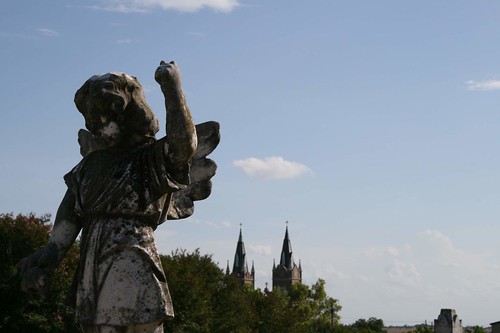
I am not a particularly good photographer but this angry angel is one of my favorite pictures I’ve taken. You can see the church spires peeking behind the trees.
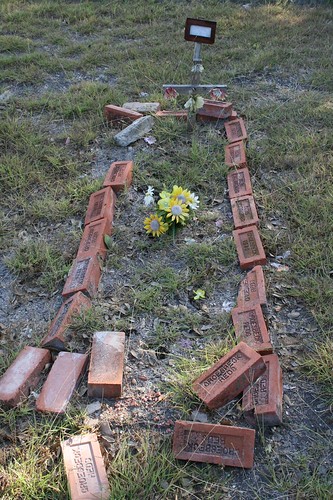
This is what I mean when I say “grim yet comforting.” No idea who is buried here, but someone made sure this plot wasn’t lost to time. Those bricks were a bit scattered but they were clearly new.
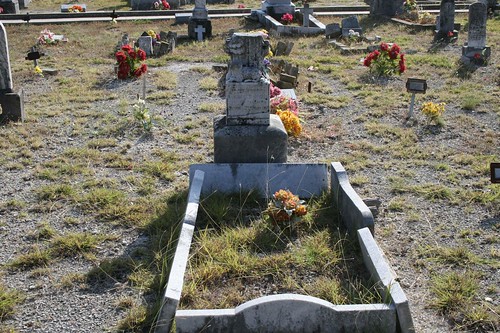
Jozef Kenovec died when he was just ten-years-old and even though it is completely weathered, his stone is very interesting. There is a lamb, representing the purity of a child who died young, and the lamb is sitting in front of what looks like a tree stump. Tree stumps are used to indicate a life cut short. I also share this picture to show the care shown the dead in this cemetery. If a grave doesn’t have fresh flowers or decorations brought by friends or family, the ladies at the church place plastic or silk flowers on the graves. There were a couple of times that had there not been a bouquet of plastic flowers, I might not have known that I was near a burial plot. His gravesite also shows how many graveyards in Europe and Eastern Europe are arranged – Holy Trinity graves often had borders around them, even when the plots were not very close to other plots. Most of the older cemeteries that interned people from Eastern Europe feature individual graves with borders, mimicking the manner in which graves are set out in places like Czech Republic, Poland and Slovakia.
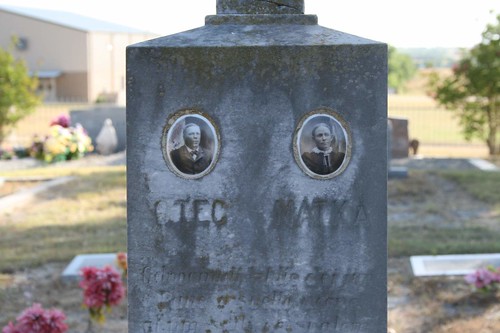
Father and Mother. In a cemetery fairly brimming with interesting graves and stones, I felt drawn to this one. The stone was too faded to retrieve their names.
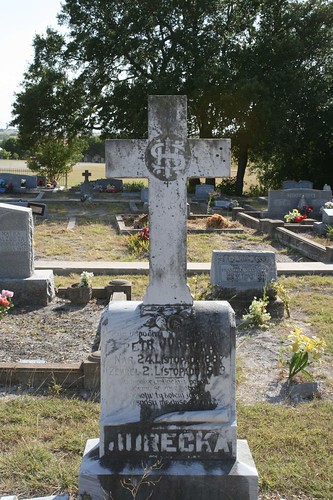
This cemetery had a lot of symbols that were new to me. The symbol at the top of the cross that looks like a stylized S is the symbol IHS, Iota, Eta, Sigma, the first three letters of Jesus’ name in Greek. Often IHS is not this stylized and it isn’t always a reference to Iota Eta Sigma. IHS can also mean Iesus Hominum Salvator, which is Latin for Jesus, Savior of Mankind. The rest of the stone was too faded for me even to try to use a Czech dictionary to decipher.
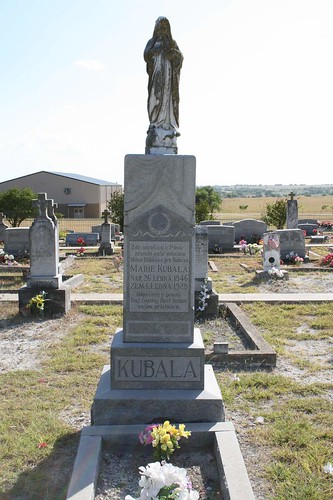
There are several Marie Kubalas in this cemetery, all related. Again, my lapsed Protestant blood was impressed by this stone. Even with the large statue of the Virgin, it has a lot going on. Across the top is drapery, that indicates a pall of mourning. Under the drapery pall there is a laurel wreath, a symbol that indicates resurrection as well as remembrance. The Czech at the top of the stone translates as “Rest in peace with the Lord, our departed beloved mother, grandmother and great-grandmother.” Other than “rest in peace” I was unable to translate the other Czech phrase near the bottom.

Frantaska Janosec died as a baby. Her’s was one of the few rough-hewn or home-made stones in the cemetery.
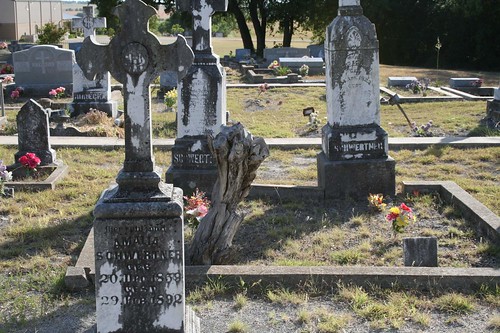
I find myself drawn to this picture because I can’t help wondering at what point the tree growing in the Schwertner corner of the cemetery was cut down or killed. Did it happen naturally? Did someone plant a tree trying to shade their dead family members? Did the tree grow and have to be trimmed down to prevent it from disturbing the graves? Regardless of the answer, there’s nothing like a dead, thwarted tree to remind you where you are – a hot, sun-baked place where the living hope to remember their own dead and possibly thwarted loved ones.
Though a handful of children were buried near their families, Holy Trinity Catholic Church cemetery has what I call a “babyland.” Others call it that, too. Sometimes babylands can feel very sad, little ones separated from their families in death. But then in some cemeteries when children are buried among adults, their little stones can seem so small and lost. I suspect there is no way to bury babies and small children that will not result in people feeling very uncomfortable.
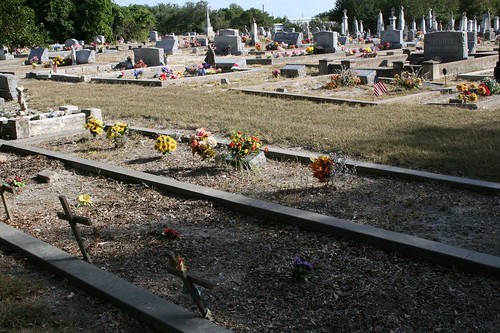
It’s just a framed-out row of dead children, with their plots marked by footstones or small crosses. Other children are buried near this concrete frame in the back, northeast side of the cemetery.
When I look back on the cemetery at Holy Trinity, it can be hard to explain my emotional connection.
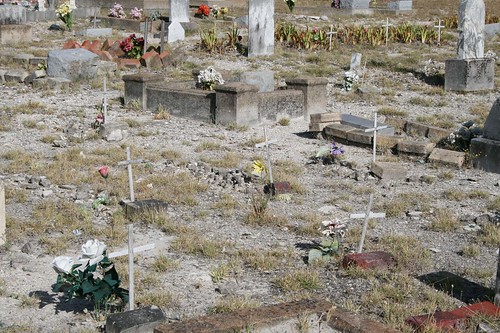
I mean, parts of it are absolutely grim.
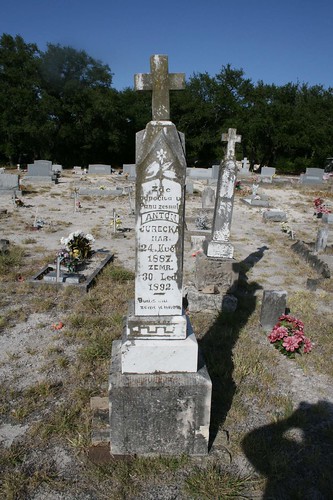
Just hardscrabble, you know. The couple of times the wind picked up, a breeze really, the dust made it impossible to get clear pictures. Despite all the history and customs I learned from these stones, there is no escaping that parts of this cemetery are rather desolate.
If I have to pin myself down, I think I love this cemetery because it was a challenge, forcing me to learn all sorts of new things to be able to know the stories of the people here. It was also the first cemetery I visited that was clearly and unequivocally an immigrant cemetery, or at least it was when the church was founded. This was a place where all the dreams of the New World ended up.
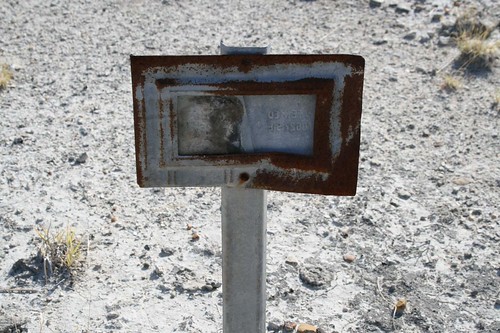
What on earth was Texas like for Czech settlers? I’m sure the mild winters here were a nice change of pace but how did they cope with the unrelenting heat during the spring, summer and fall? The complete lack of infrastructure? Did they feel like they were finally living in a place with infinite possibility? Or did they look out at the scorched earth in July and think, “I want to go home.”
I like to think I am a person devoid of much sentimentality but clearly I’m not. The stories of the dead affect me, and the stories of those at the Holy Trinity cemetery, for whatever reason, affected me the most, as a whole, than those in other cemeteries. Perhaps it is because this cemetery, so full of stories, was so desolate in places. Perhaps it is because I am a sentimental fool with very specific triggers. I’ve been to prettier and more visually interesting cemeteries but Holy Trinity Catholic Cemetery is one of those places that spoke to me in a way that others didn’t.
So again, my experiences in Texas were not creepy, though I suspect at night this could be a very unsettling cemetery. This time I was led by curiosity and ended up a mawkish sadness. If any of you want to see all the photos I took that day, the whole set is on my Flickr account.
I loved this entry and I kind of want to go there now.